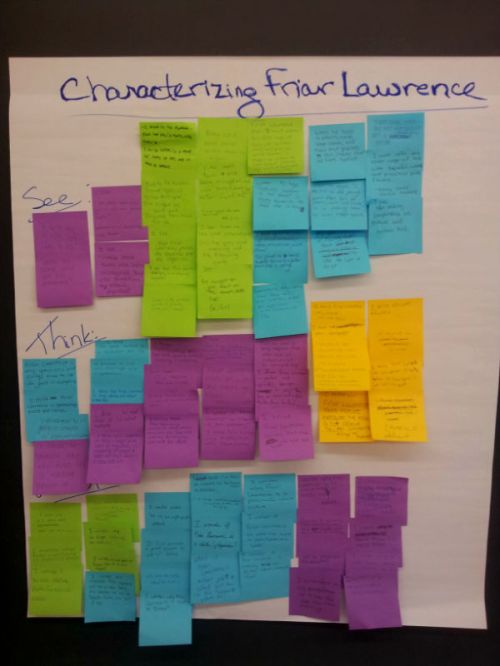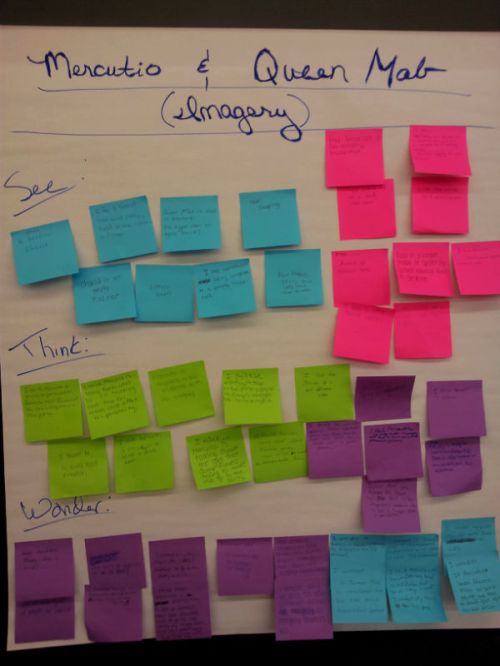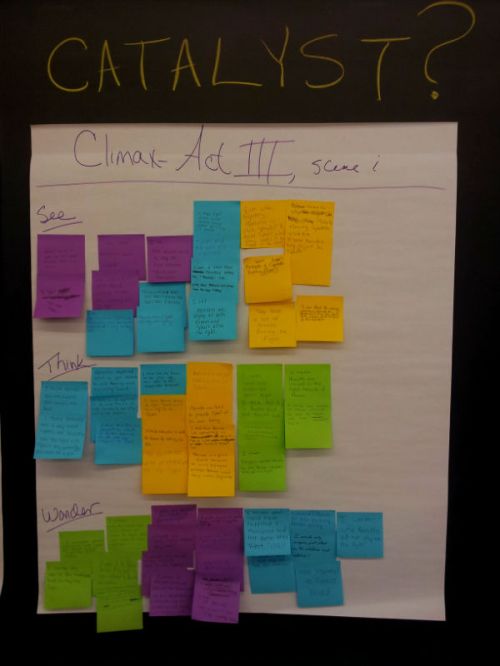4a. Reflecting on Teaching
As I look back on this 2012-2013 school year, I can see some things that really worked for me and for my students, and I will not be changing those. For example:
~ Working in cooperative groups for various units. This tends to work better at the enriched level as opposed to the regents because the enriched kids tend to be more focused and not quite as chatty about things non-related to the task at hand. As we did close reading of materials, I found that some weaker students benefited from having a strong reader in the group to kind of lead them along. Quite often I heard phrases like, “How’d you come up with that?” and “Show me where you got that cuz I ain’t seein’ it.”
~ Using Visible Thinking Exercises. This technique has been the single greatest tool I have gotten in the past several years through Professional Development. I wish I had been introduced to it much earlier! Using these exercises helps to focus writing, especially the See/Think/Wonder exercise for coming up with Concrete Details (CDs) and Commentary (CMs) for writing. Students become more observant while examining paintings/photographs/music videos/film clips, and they begin to look for less obvious details as the year progresses. This skill is transferred to close reading as we examine specific passages from text. The regents students did it with articles about migrant farm workers, as well as articles relating to Roosevelt’s New Deal in the first quarter when we read Of Mice and Men. During that time, the enriched students were working with Every Bone Tells a Story, and each group did close readings relating to a particular hominid. When all classes were working with The Odyssey in some form in the second quarter, students examined passages of the poetry, or analyzed Homeric similes. Both levels were also given speeches from Shakespeare’s Romeo and Juliet to analyze closely, and the enriched kids had to analyze and memorize a 20 line piece from one of Shakespeare’s other plays. And we use the Visible Thinking technique with Frankenstein (9E) and Plato’s “Apology” (9R) in the fourth quarter.
~ Every Bone Tells a Story as a non-fiction work for English 9 Enriched. I love how the book was divided into the four hominins, and then each section was divided into: Discoveries (Expository Writing), Deductions (Research), and Debates (Persuasive Writing). Each group worked with each of the three types of writing as it pertained to their assigned hominid. This worked very, very well at the beginning of the year as I was introducing the different types of writing that we would be doing during the rest of the year. Since I plan to keep using this book, I hope that the district can find the funds to purchase copies for the students instead of me having to ask them to buy the books themselves.
~ Plato’s “Apology” and Evidence-Based Claims. Ok, I have to admit that I dragged my heels on this one, but only by trying it out would I really have the right to complain (hence, following the PARCC framework for the first quarter?). I was actually surprised at how much the worksheets reflected work that I was already doing with my students. The Forming Evidence Based Claims worksheet is actually a version of See/Think/Wonder, while the Organizing Evidence Based Claims worksheet asks kids to create a thesis statement with two signposts (something I’d already taught them earlier in the year). While I would not change teaching it, I WILL do this in the beginning of the year with students and use the worksheets consistently (I found they work well for literature as well because I used them with Frankenstein in the enriched classes).
Things that I will change:
~ no PARCC framework next year. It’s too much work for a single teacher to keep up with.
~ “Apology” will be moved to the beginning of the year, followed by short stories. I began the year with Of Mice and Men, and I really didn’t like the flow. However, I had been following the PARCC, so I jumped right into a full-length text. It would have been a better transition to do the Evidence-Based Claims with Plato first, and then transfer that skill to a full-length research project instead of the other way around; however, in my defense, the Plato unit wasn’t available in September.
_________________________________________________________________
4b. Maintaining accurate records
One tool that helps with maintaining accurate records of dates and times of when work was turned in is the online website that I have for each classroom. From my own funds, I purchased five networking classroom websites from Spruz.com. Each class is held privately, meaning that no one may join in or visit the website unless he/she is a member approved by me. I maintain the highest privacy allowances on the site in an attempt to insure student internet safety, and no one may join the site using a made-up screen name. This is so that I know exactly who is responsible for posting anything on the site. When an assignment is completed online, it is dated and time-stamped, so I know exactly when it was done. There is no argument about late assignments with this tool.
I also make use of the Infinite Campus grade book online. Parents may see grades on the portal and keep track of their child’s progress. I have both positive and negative reactions to this. On the positive side, parents can see what a child is missing and encourage him/her to turn the work in, or if the child does poorly on a quiz, the parent can intervene with the child. On the flip side, some parents check the portal constantly and question grading practices for every little point in an attempt to raise their child’s grades.
_______________________________________________________________
4c. Communicating with families
All information about the course is sent to the parents over the summer so that they are informed about what their child can expect. I send expectations, supplies lists, and a list of reading materials for the upcoming school year.
Most frequently, I communicate with families via email. This gives me an electronic record of the communication, and I always include Mr. McBride (as English Department Supervisor) and the student’s house office administrator in the conversation. I send emails for significantly late work, failing averages at the halfway point in a quarter, or missing work, and I make suggestions for how a student may improve his/her grade. I also send emails when a struggling student has improved as a motivation for continued improvement. If a parent does not respond to my email I follow with a phone call and log the call on Infinite Campus.
_______________________________________________________________________
4d. Participating in a professional community
I serve as a member of the Webster School District Policy Board where we work to design and bring about meaningful professional development opportunities for our teachers. Our biggest push this year has been for putting together Creative Collaborations where teachers can work together on a common goal.
I participate in a PLC with another 9th grade English teacher, but I also discuss curriculum and other school business with other teachers as well.
For the past three years, I have served the school as the head yearbook advisor, maintaining accurate financial records and helping students and my co-advisor create a quality product. I have also served as a ski club chaperone for the past eight years, and I was a class advisor for three years from 2007-2010. Our committee planned the 2008 Junior Prom and the 2009 Senior Ball.
This will be the fifth year that my students will have published an anthology of short stories that follow the Hero’s Journey pattern outlined by mythologist Joseph Campbell. Each year, the short story project dovetails one of the units that we have worked with. In the 2008-2009 school year, we read real-life stories of heroes. Because of the popularity of the television show Heroes at the time, we patterned our story after the television show by giving ordinary people super-powers and creating our own superhero tales in In The Footsteps… In 2009-2010, we read Douglas Adams’ The Long Dark Tea-Time of the Soul in which humans created immortal characters/gods in their cultures and then later forgot about them. Because the characters were immortal and could not die, they became the forgotten and lonely street-people. Our task was to “rescue” an immortal by taking the time to learn and tell the story of a student-created immortal who was on the brink of being forgotten forever in We Remember… During the 2010-2011 school year, we read The Hobbit, and so students created quest tales that included a long journey. The culmination of that project was Forged Through Trials. Last year’s project was also inspired by a television series and went with our Cultural Mythology unit. In the spirit of Once Upon a Time, students selected a myth or fairy tale and modernized it. The end result was Altered Reflections. Each book was published online and is currently available worldwide. This was the project followed by the Joseph Campbell Foundation that led to my participation in the international Symposium on Mythology. This year’s project surrounds a non-fiction work, Every Bone Tells a Story. Students selected one of the four anthropological discoveries from the text, and they researched the region/culture in which the person may have lived. From there, they are putting flesh on the bones and creating stories for the hominins. Lapedo Child and Turkana Boy might have rite of passage tales or a coming of age story. Kennewick Man might have a long-journey story, while Ice Man just might be a murder mystery. All might include Land of the Dead tales. The possibilities are many, so students have the opportunity to be creative all the while honing their research skills as the settings must reflect the region and ancient culture. The students then vote on the top stories to be included in the anthology. At the end of the project, I present the students’ published work at the 9th grade awards ceremony, and we have a book signing celebration in the school library, complete with a cake bearing the book’s cover.
____________________________________________________________________
4e. Growing and developing professionally
I am a member of the Joseph Campbell Foundation, which correlates with my work in teaching cultural mythology and The Hero’s Journey to my students. In 2012, I was selected to present at an international Symposium on Mythology in Santa Barbara, California about the work I have done with my enriched students over the years, particularly the long-term short story project that we do annually, which culminates in the publication of an anthology. As a result of my presentation, the Joseph Campbell Foundation has asked me to serve as one of the lead teachers on a committee that will create an international curriculum on mythology to be funded by a grant from the National Endowment for the Humanities.
I have taken advantage of the Webster Central School District’s professional development offering on Visible Thinking activities in the classroom. This practice has really added depth to my classroom discussions and to student sharing/writing. There are examples of Visible Thinking exercises posted for your perusal.
______________________________________________________________
4f. Demonstrating professionalism
I work hard to maintain my integrity in my chosen profession. I take my charge to educate students very seriously, and I am consistent in my dealings with students. While I may be strict, I believe that I am extremely fair and that I do whatever is necessary to see students succeed.
I offer credit recovery options for students who are missing work. Because I believe that all assignments are important and should be completed, I have given students “incomplete” grades on report cards until all work has been done.
43.161030
-77.610922






